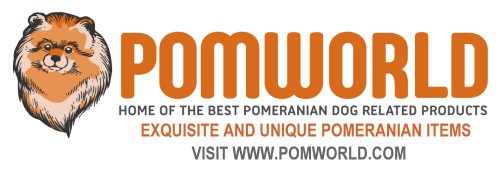Last Updated on 29/04/2022 by Dochlaggie. Post first published on April 29, 2022.
An indicator of good health in dogs is bright and shiny eyes. Shiny and bright eyes indicate basal tears are being created. Tears moisten the eyes and protect them from dust and other very fine debris.
However, if your Pomeranian has very watery eyes the result is an ugly Pomeranian eye stain. Excess tears will pool under the eyelids and then run down over the dog’s lower lids and moisten his facial hair.
If it happens too often, the tears may stain the dog’s hair and that should be sufficient reason to diagnose the cause of the Pomeranian watery eyes.
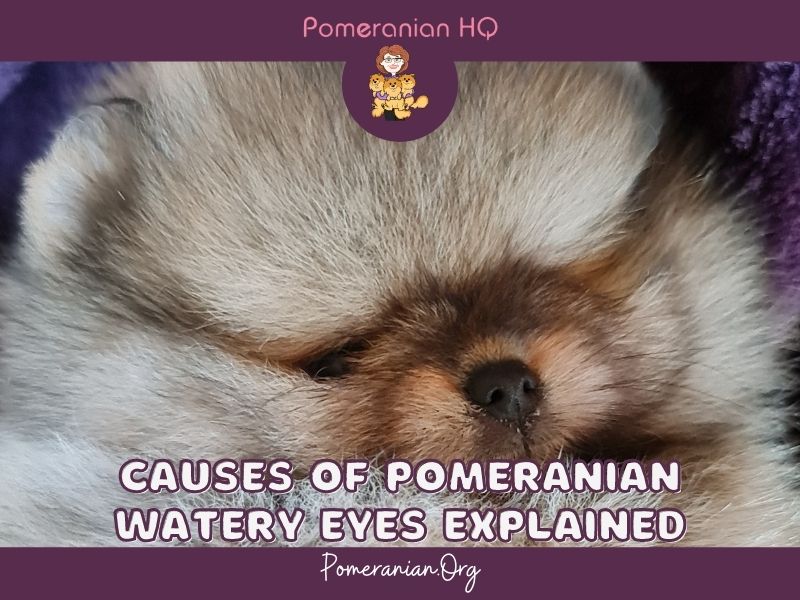
Why Do Pomeranian’s Eyes Water?
Certain health conditions cause Pomeranian watery eyes and Pomeranian eye problems so it’s vital to find the correct root cause of this problem. While it may be assumed that tears are just water, tears actually consist of many elements.
Tears are a salty fluid, chock full of protein, water, mucus, and oil and come from the lacrimal gland in the upper, outer region of the eye.
How Blinking Affects Tear Production
Eyes will stay safely moist because of the ongoing creation of tears. Fresh fluid is held in the tear ducts and lower and upper lids. Each time your Pom blinks, fluid seeps out over the eye causing Pomeranian tear stains.
Pomeranian Eye Problems
There’s no official length of time that states whether a medical problem is chronic or acute. It may be hours, days, or even weeks. However, with regard to the Pomeranian watery eyes problem, an acute case should disappear on its own within 24 hours.
The major reason for acute runny eyes is when a foreign substance enters the eye. The dog’s reaction is to create excess tears to wash away this foreign matter.
Even if only one eye gets affected, your Pomeranian will naturally blink both eyes. That normally causes additional tears to be produced. Combine that with the overflow and his eyes will end up being extremely watery.
Tiny pieces of dirt are the biggest cause of watery eyes and this happens easily if the dog has been sniffing in grassy areas, or if your dog spends time outside in very dusty and windy conditions.
An eyelash or strand of facial hair may also get trapped in the eye itself. If you gaze into your Pom’s eyes and see the offending fragment, you can usually solve the problem by flushing it out.
If the object had been in the dog’s eye for a couple of hours, the eye may take a couple of hours to settle down. Also, the tiny element in the eye can cut any part of the Pomeranian’s eye and that means more advanced treatment must be sought.
How to Clean Pomeranian Eyes
To flush out a Pomeranian’s eyes to eliminate the irritant, you need to use a good quality eye rinse. However, if you don’t have them handy, human eye drops can be used instead.
The ideal method is to gently pull the lower lid out and let two or three drops fall into the eye. Once you let go of your dog, he’ll instinctively blink a few times and this spreads the fluid and helps wash the element away.
If for some reason, this doesn’t work, or if other problems arise, you should get your dog to the vet for a professional assessment. Don’t leave it for more than 24 hours because the cornea itself may be damaged.
If you’re not sure if your Pom’s eyes are serious enough to contact the vet, do it anyway. He can carry out a simple test that will result in knowing if the tears are excessive.
It’s an easy procedure where a small, thin sliver of special paper is placed in the lower eyelid. It has numbers that give a reading of how many tears are being made. A range of 15 – 20mm per minute is normal. If the dog is a senior, then a lower reading would be normal.
Major Causes of Pomeranian Dog Eye Problems
There are a couple of possible health problems that can cause too many tears to be produced and Pomeranian eye problems.
Pomeranian Allergies
This is the number one reason why a Pomeranian may have watery eyes. If the fluid is brown, green or yellow, thick or crusty, a different health problem will be present.
If you don’t regularly wipe your dog’s eyes with canine facial wipes, the fluid may dry and turn tan or red in color. Food and seasonal allergies and possibly, to a lesser extent, contact allergies.
Most allergies will also cause other symptoms such as itchy skin (causing your pet to lick or chew at different body parts; sneezing and/or possible hair thinning.
If your pet is intolerant to specific foods, other symptoms may appear including dry retching, vomiting, and/or changes to his stools. Allergy-related watery eyes can occur anytime and a dog can grow into or out of said allergies.
Triggers can come from weed and grass pollens, flea control products, and dust mites. Because of this, it’s wise to ask your vet to carry out a skin test to identify the trigger (s) that are present.
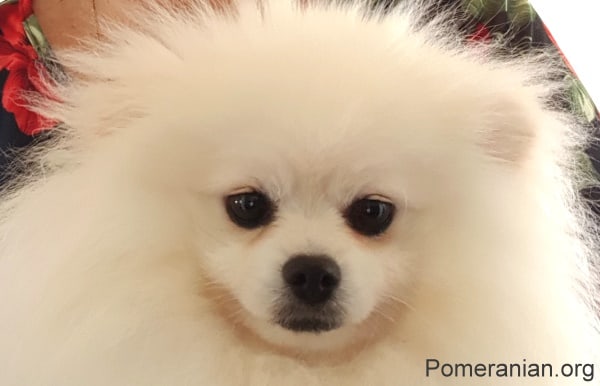
Pomeranian Blocked Tear Ducts or Tiny Tear Duct Issues
This is another common cause of Pomeranian eye discharge. Sometimes the excessive tear stains will be the only symptom. However, the eye may be red and have some irritation. Flushing the tear ducts can help in some cases and surgery may be the only choice in others.
Corneal Injury
The cornea is the outer layer of the film of the dog’s eye and it’s designed to act as a protective shield. Unfortunately, it’s easily scratched. Dogs love sniffing around in the garden and the eye may get scraped by a twig. In the bedroom or lounge, the corner of a blanket may do the same thing. A runny eye could be the only symptom.
Unfortunately, in moderate and severe cases, the tissue surrounding it can go red and it may swell up a little. One eye can easily tear up more than the other. One eye may be reacting to injury and the other is coming to its aid.
Your vet can usually work out the depth of the injury. If there are minor scratches, the main aim is to stop him from touching his eye so it can heal on its own, usually within a week or so.
An Elizabethan collar is generally put around his neck to stop this from happening. However, some people dislike this method and a soft contact lens may be their solution. Antibiotics are usually prescribed to stop any infection during this more vulnerable period.
Corneal Ulcers
Superficial or deep corneal ulcers are very painful for your dog. These corneal ulcers are caused by corneal trauma, disease, lack of tears, foreign objects in the eye, and other injuries.
These corneal ulcers cause severe eye discharge, redness, light sensitivity, frequent rubbing of the eyes with paws, and film on the eye.

Pomeranian Entropion
This is a genetic condition that pushes the dog’s eyelid partly inwards, thereby making his eyelashes brush against the eye itself, making them tear up. This condition is nearly always diagnosed by the time your puppy turns one. Because dogs are never born with this condition, a dog aged one or more won’t contract this condition.
A stray hair or eyelash is still always possible. Pomeranian puppies with Entropion often grow enough for the problem to be fixed without surgery.
Owners shouldn’t rush into surgery for their pets. If his eyelashes are causing trouble, prevent further risk of damage to his eyes. Keep the lashes soft by smearing petroleum jelly on them a few times each day until the problem ceases or surgery is carried out.
It’s simple to diagnose with an eye examination and the vet will also check to see if any ulcerated corneas have appeared. Minor cases are generally handled with antibiotic eye drops. Most moderate and, certain severe cases, undergo corrective surgery.
Glaucoma
Glaucoma is a collection of eye conditions that harm the optic nerve, thus resulting in poor vision. It is caused by excessive pressure on the eye. Severe glaucoma results in torn and cloudy eyes. It is a very painful condition for dogs, and usually, surgery is recommended. So, try to consult with a veterinarian to manage ocular pressure with medicine. But surgery may be recommended.
Distichiasis
This condition can cause runny eyes that don’t involve the lids, just the lashes. One or more lashes will bend inwards and tickle the dog’s eye, making it water.
This may happen on upper, lower, or both lines of eyelashes. Symptoms include watery eyes, possible red eyes, slight swelling, and discomfort that will cause your Pom to paw at his eye or rub it along furniture or carpet.
I strongly recommend owners who have a dog with this problem get treated urgently because it can cause severe ulceration of the cornea and ongoing infections.
Treatment is generally by the use of a particular type of electrolysis known as electro-epilation. A small current of electricity destroys lash follicles permanently.
Epiphora (Excessive Tearing)
Epiphora is a state of an overflow of tears from the eyes. Epiphora is a symptom/condition rather than a disease. Epiphora appears as dampness or wetness beneath the eyes. Other signs are reddish-brown staining of the fur beneath the eyes.
This condition may result from abnormal eyelashes, eye infection, inflammation, corneal ulcers, tumors, eye pain, allergies, etc.
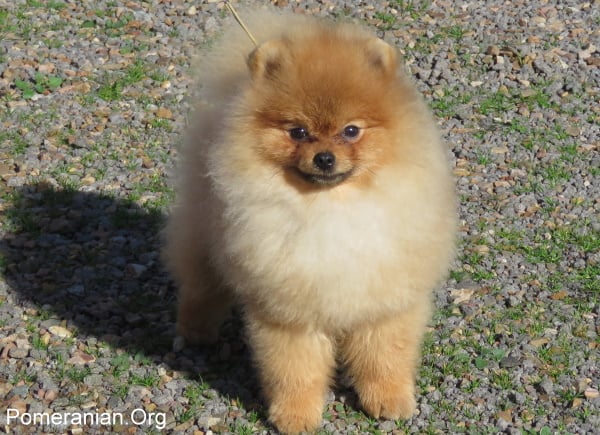
Conjunctivitis
A Pomeranian can get watery eyes due to either viral or allergic conjunctivitis. Typical signs include puffy eyelids and redness.
The discharge won’t be a clear, watery fluid. It will be thick and, in most dogs, it will dry to a sticky crust overnight. It can literally glue the eyes shut when the dog tries to open them when he wakes up.
The discharge is stretchy and stringy when you attempt to wipe it off. Allergic conjunctivitis may be caused by a dust mite allergy, seasonal triggers such as pollen, and even environmental factors such as perfumes and cleaning products. Treatment includes antihistamines, cold compresses, and eye drops that have steroids to decrease any swelling.
If a Pomeranian has viral conjunctivitis, you must know that it’s very contagious to people and other pets. A dog may also have a cold, throat infection, or lung infection.
Treatment will vary, depending on any other issues at the time. Basic care would be cold compresses, antibiotic drops, and steroid drops.
The dog recovery period is around three weeks. During that period, always wash your hands after touching him, particularly if you’re looking after his eyes or cleaning him. Infection or other illnesses.
In some cases, a lung infection or other health issue may cause runny eyes, a runny nose, or both. Vets would check this normally regardless of what symptoms exist, even if there’s no known cause.
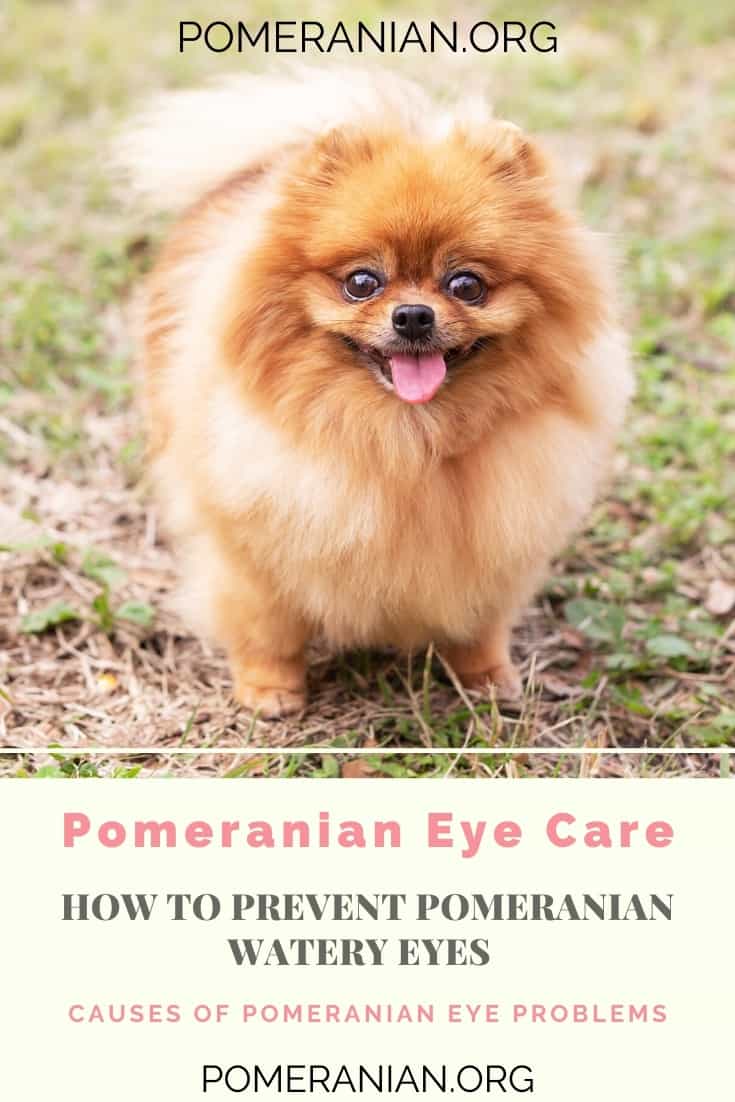
How to Apply Eye Medication For Your Pomeranian
Treatment of the eyes is usually done with eye drops or ointments. These therapeutics can be applied with a few simple tips.
- First, clean your Pom’s eyes area with warm water and a cotton ball.
- Keep eye drops in hand and slightly tilt your Pom’s head back. Gently open the lid of the dropper. Place one hand on the dog’s face and keep it tight to prevent injury by dropper hitting your Pom’s eyes. Squeeze eye drops in the upper part of the dog’s eye.
- If you apply eye ointment, gently open the lower eyelid to create a pocket. Similarly, keep a hand on the dog’s face to restrain his head.
- Squeeze drops in the eyes
- Contact your vet and follow his advice if you do not get any points mentioned above.
Pomeranian Watery Eye Prevention
Pomeranian parents need to know how to prevent Pomeranian eyes from watering. Even the tiniest of scratches and pieces of tiny debris can make your eye run.
You can do a few things to prevent Pomeranian eyes from watering, watery, or causing Pomeranian tear stains.
- Routinely clean your Pom’s face and eye area to get rid of all tiny pieces of debris, including food that may eventually get into his eyes. Wiping the lids in a downward motion, so the lids are gently closed as they’re being cleaned. Use a high-quality canine facial wipe. If your pet is susceptible to staining, use a wipe that also cleans stains and eliminates debris.
- Many dogs suffer eye injuries while running through gardens or areas where there’s high grass. In such places, there are extra hazards (snakes, insects, and ticks) to consider. It’s wise to restrict your pet’s fun time to areas with little grass.
- Keep eye drops/cleanser on hand in your grooming kit. If your Pom gets something in his eye and makes it water and irritates it, you can swiftly treat this at home. Human eye drops are fine, but they have a limited life once you open them. Replace such items regularly.
- Even for minor runny eye issues, maintain a vigilant gaze on things.
Take your Pom dog to the vet if any Pomeranian eye problems don’t settle on their own inside 24 hours or if any other symptoms manifest themselves.
Refer to the Grooming section regarding dealing with Pomeranians and eye staining.
Copyright Pomeranian.Org. All Rights Reserved.
Disclaimer: The Content is not intended to be a substitute for professional veterinarian advice, diagnosis, or treatment. Always seek the advice of your veterinarian with any questions you may have regarding the medical condition of your dog. Never disregard professional advice or delay in seeking it because of something you have read on ANY website.
N.B. This article regarding Pomeranian health issues was written in consultation with our resident veterinarian.
Dr. Muqeet Mushtaq
DVM, University of Animal and Veterinary Sciences, 2019
MSc. (Hons.) (Animal Breeding & Genetics), University of Agriculture Faisalabad, 2021
References and Further Reading:
Denise Leo, The Pomeranian Handbook.


